
The Strange Dichotomy
Twisting and turning upon itself in great loops and bends, the river Tamar between Gunnislake and Plymouth flows through a hilly and tumbled valley rich in surprises. Half in Cornwall, half in Devon, its unusual and varied scenery is among the least known in the country and it hides relics of an industrial past hardly known outside Devon and Cornwall. The Tamar Valley today is devoted to agriculture, but in the 1850’s and 60’s it rivalled West Cornwall in importance as a source of copper. For nearly thirty years after that it was the centre of arsenic production in the British Isles, and it had long been recognized as an important area of lead and silver mining. At a time when ships were changing from sail to steam, furnace-
 History of Devonshire.
History of Devonshire.
their residence at Warleigh. The heiress of the Folio!! » brought it to the Gorges, and from them it passed, by
female heirs, to Bonvile, Coplestone, and Bampfylde . For some century and a half it has been the seat of the Radcliffes. The Coplestone oak, which stood on the grim by the church, was the traditional scene of a murder by one of the Coplestones, the ‘ fatal oak ? of Mrs. Bray's ‘Warleigh.’ Gilbert Foliott, successively Abbot of Gloucester, Bishop of Hereford (1149), and Bishop of London (1161 ), was a native of Tamerton. One of the most learned men of his day, he was also a steady opponent of A Becket, and was excommunicated by that primate and the Pope accordingly, but relieved by a synod which he called. He held the See of London twenty years.Maristow in this parish, the seat of Sir Massey Lopes, was the site of the ancient chapel of St. Martin (whence the name) belonging to the canons of Plympton. After the Dissolution it came to the Champernownes, who sold it in 1550 to John Slanning of Shaugh. Thence it descended with the rest of the Slanning estates, and was bought by Sir Masseh Manasseh Lopes in 1798. It seems probable that Maristow was the chapel of St. Martin de Blakestane (the next Domesday manor to Tamerton), held by the Priory temp. Henry I., and given by Paganel. It is also said to have been the gift of William de Pin and his daughter Sibella.
 CHAPTER XXIV .
CHAPTER XXIV .
PLYMOUTH, DEVONPORT, AND STONEHOUSE.
I'm recorded history of Plymouth cannot be traced much In (her than the Norman Conquest. The town finds no mention in the ‘ Saxon Chronicle.’ Risdon, indeed,
citing the life of St. Indractus, tells us that by the Saxons it was named Tamarweorth , which is much more
likely, if the reference has any historic value, to be the Saxon name of what is now Drake’s Island — ‘ the Island of the Tamar.’ Leland also asserts that much of what afterwards came to be called Plymouth was held by the canons of the ancient Saxon college of Plympton, which Bishop Warelwast made the foundation of the famous Plympton Priory. But these statements have no authority ; and the earliest undoubted and distinct mention we have til Plymouth is as the Sutton of ‘ Domesday,’ held by William in succession to the Confessor, an insignificant manor, with an enumerated population of 7 only. It was many a long year after this that the manor was granted by the Crown to the Valletorts, and by them in part to the monks of Plympton ; and that mainly by the fostering care of the prior and his brethren, though largely as the result of independent effort, the foundations of the chief centre of population of the West were laid.“ Domesday “ affords the materials for a striking comparison between past and present, The eight manorsast and present. T he eight manors,
